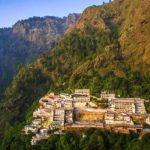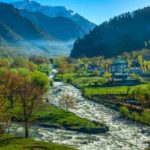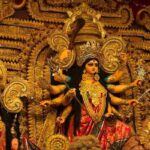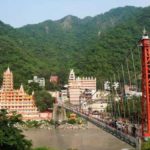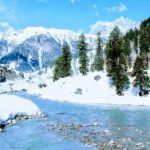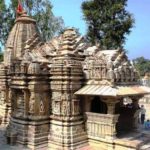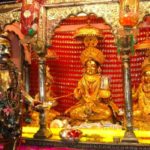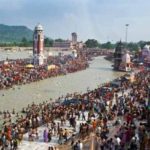Vaishno Devi Travel Information is a temple town that’s home to the famous Vaishno Devi Mandir. Located in Trikuta hills, 13 kms from Katra (in the union territory of Jammu and Kashmir); this renowned shrine allures millions of devotees from all over the world. Popularly known as Mata Rani, Vaishnavi and Trikuta, Vaishno Devi is a manifestation of the Hindu Goddess Durga. It is believed that during the pooja and aarti, Goddesses arrive at the Holy cave to pay their respect to Mata Rani. Devotees believe the goddess herself calls the devotees to reach here.
Vaishno Devi is said to be Moonh Maangi Muradein Poori Karne Wali Mata (the mother who fulfils the wishes of her children). The darshan of Maa Vaishno Devi in the holy cave is in the form of three naturally formed rocks which are known as pindies. These pindies manifest the three forms of the goddess as Maha Kali, Maha Saraswati and Maha Lakshmi. More than one crore devotees visit the Vaishno Devi temple each year Vaishno Devi Tour Packages.
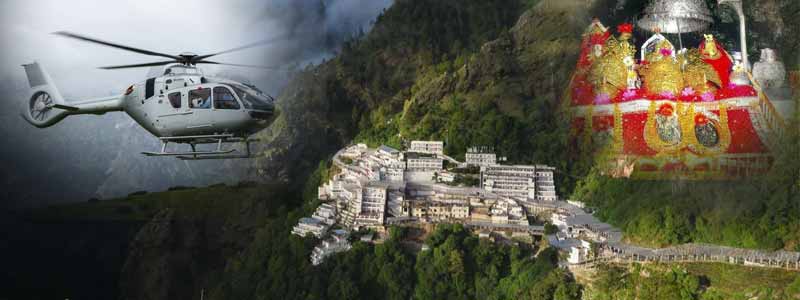
History of Vaishno Devi
Vaishno Devi Temple is one of the oldest temples in India. It has a rich history which is still unknown to a lot of people. It is not possible to ascertain everything that has happened but, there are certain things that we know about and are eager to share.
A study says that the Vaishno Devi Temple is millions of years old. There was no mention of truth that a female deity was worshiped. The acknowledgment of worshiping Shakti was started, in the Puranic period, at the time of Mahabharata. Before the famous war of Kurushetra between Kauravas and Pandavas, Shri Krishna advised Arjun to take blessings of Mother Goddess for victory. A good amount of people believed that Pandavas were the first to build the temples at Bhawan and Kandoli for showing gratitude for Mother Goddess.
It is also believed that there were five stone structures of Pandavas built adjacent to Trikuta mountain in the holy cave. The historical visit to the Vaishno Devi Temple is of Guru Gobind Singh and was said to be there in the Holy cave who have gone there via Purmandal.
A lot of people still have a believe that the energies of Maa Vaishno Devi Tourism surround the shrine of Vaishno Devi Temple. The head of Goddess Sati fell there which has been disputable whereas, other claims that Goddess Sati’s forearm fell here at this place. The Vaishno Devi Temple is the oldest and holiest shrine of all Shaktipeeths.
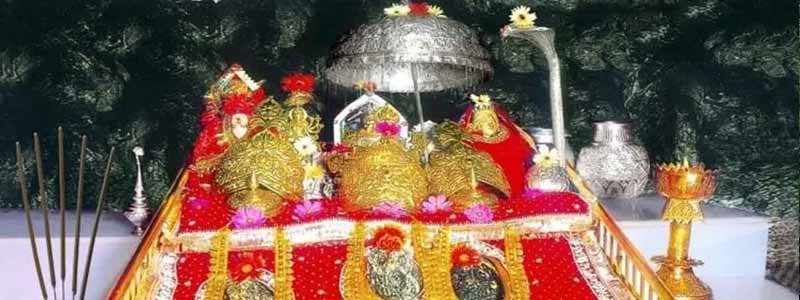
Places to Visit in Vaishno Devi
Vaishno Devi, a renowned Hindu pilgrimage destination in Indian-administered Kashmir, offers not only the spiritual experience of visiting the Mata Vaishno Devi Temple but also the opportunity to explore some beautiful and scenic places in the surrounding region. Here are some of the prominent places to visit in and around Vaishno Devi:
Mata Vaishno Devi Temple: The primary reason for visiting Vaishno Devi is to seek blessings at the Mata Vaishno Devi Temple. The temple, located inside a cave at an altitude of approximately 5,200 feet, requires a 13-kilometer uphill trek from the base camp at Katra.
Ardh Kuwari Cave: En route to the Vaishno Devi Temple, pilgrims pass through the Ardh Kuwari Cave. It is believed that the goddess meditated here for nine months before slaying the demon Bhairon Nath.
Bhairavnath Temple: After seeking the blessings of Vaishno Devi, many pilgrims visit the Bhairavnath Temple, situated around 2.5 kilometers from the main temple. Bhairavnath is believed to be a guardian deity of Vaishno Devi.
Banganga: Banganga, a small stream, holds great significance in the Vaishno Devi pilgrimage. It is believed that the goddess quenched her thirst at this spot during her journey to the Trikuta Mountains.
Sanjichhat: Located approximately 2.5 kilometers from the Mata Vaishno Devi Temple, Sanjichhat offers breathtaking views of the surrounding mountains and valleys. It is a popular resting point for pilgrims during the trek.
Adhkunwari Temple: Situated around 6 kilometers from Katra, Adhkunwari Temple is another important religious site. It is believed that the goddess hid in this cave while escaping the demon Bhairon Nath.
Himkoti: Himkoti, about 2.5 kilometers from the temple, is a beautiful vantage point offering stunning views of the valley below. It also has a small temple and a picturesque garden.
Vaishno Devi Temple Viewpoint: This viewpoint, located about 1.5 kilometers from the main temple, provides an awe-inspiring view of the entire temple complex and the surrounding landscape.
Charan Paduka Temple: Around 1.5 kilometers from the main temple, Charan Paduka is believed to be the place where the goddess’s footprints are imprinted on a rock.
Vaishno Devi Temple Museum: Situated at the base camp in Katra, this museum showcases the history and mythology of the Vaishno Devi Temple through various artifacts and exhibits.
While the main attraction is undoubtedly the Mata Vaishno Devi Temple, these surrounding places offer pilgrims and tourists an opportunity to explore the natural beauty and religious significance of the region. The combination of spirituality and picturesque landscapes makes Vaishno Devi a memorable destination for visitors from all walks of life.
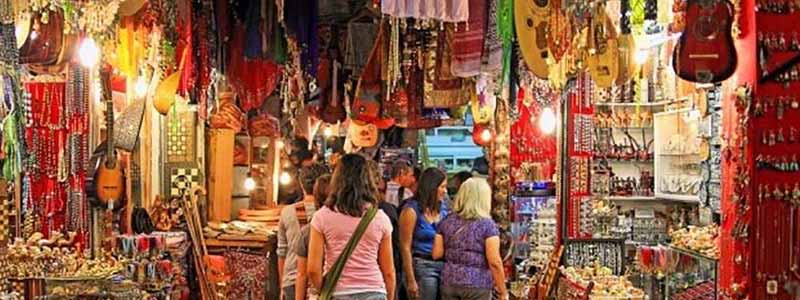
Famous Shopping Markets in Vaishno Devi
Vaishno Devi and its nearby town of Katra, being major pilgrimage destinations, offer limited shopping options compared to larger cities. However, there are a few local markets and shopping areas where visitors can find religious souvenirs, traditional handicrafts, and other items to take back as mementos of their pilgrimage. Here are some famous shopping markets in Vaishno Devi and Katra:
Katra Main Market: The main market in Katra, located near the base camp, is a bustling hub for pilgrims and tourists. Here, you can find shops selling a wide range of religious items, such as idols, pictures, prayer beads (mala), rudraksha, and other religious souvenirs. You can also find clothing, shawls, and other local handicrafts.
Vaishno Devi Market: Situated near the Vaishno Devi Temple, this market caters specifically to the needs of pilgrims. You can find shops selling offerings for the goddess, including flowers, coconuts, and other puja items. It’s a convenient place to buy religious items before starting the trek to the temple.
Ardh Kuwari Market: This market is located at the halfway point between Katra and the Vaishno Devi Temple, near the Ardh Kuwari Cave. It offers a variety of religious articles, souvenirs, and refreshments for pilgrims taking a break during their trek.
Katra Market Complex: This is a government-run market complex in Katra, where you can find shops selling authentic Kashmiri handicrafts, such as Pashmina shawls, woolen clothing, saffron, and dry fruits. It’s a great place to buy high-quality souvenirs and gifts.
Raghunath Bazaar: While not in Vaishno Devi or Katra, if you’re traveling from Jammu to Katra, Raghunath Bazaar is a famous shopping area in Jammu city. It offers a wide range of goods, including clothing, jewelry, and handicrafts, making it an excellent spot for shopping before or after your pilgrimage.
When shopping in these markets, it’s essential to practice your bargaining skills, as prices can be negotiable, especially for non-religious items. Additionally, be cautious when purchasing religious artifacts to ensure their authenticity and quality. Remember that these markets primarily cater to pilgrims, so the majority of items will have a religious or spiritual theme.
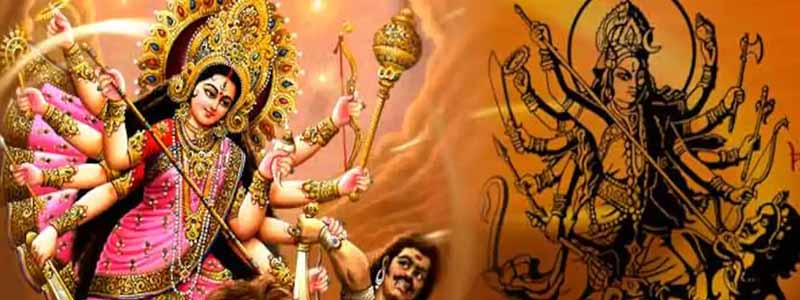
Fair & Festivals of Vaishno Devi
Vaishno Devi, being one of the most revered Hindu pilgrimage sites, witnesses several fairs and festivals throughout the year, adding to the spiritual and festive ambiance of the region. Some of the significant fairs and festivals celebrated in and around Vaishno Devi are:
Navratri: Navratri, meaning “nine nights,” is one of the most important festivals celebrated in Vaishno Devi. It occurs twice a year, during the Chaitra (March-April) and Ashwin (September-October) months. The festival honors Goddess Durga and her various manifestations. During Navratri, the temple and its surroundings are beautifully decorated, and special prayers and rituals are conducted by devotees.
Vaishno Devi Mela: This annual fair takes place during the Navratri festival in the Chaitra month (March-April). It is a week-long celebration, during which the entire area around the Vaishno Devi Temple is adorned with colorful decorations. Pilgrims from various parts of India and beyond throng the temple during this time to seek the blessings of the goddess.
Sharad Navratri: The Sharad Navratri, celebrated during the Ashwin month (September-October), is another significant festival dedicated to Goddess Durga. During this time, the temple complex is illuminated with lights and decorations. Many devotees undertake the pilgrimage during these auspicious days to seek blessings and perform special prayers.
Diwali: The festival of lights, Diwali, is celebrated with great enthusiasm at Vaishno Devi. It falls in the month of October or November. The temple and the entire town of Katra are adorned with lamps and lights, creating a mesmerizing atmosphere. Devotees offer prayers and seek blessings during this auspicious occasion Vaishno Devi Travel Information.
Holi: Holi, the festival of colors, is celebrated with joy and fervor by locals and tourists in Vaishno Devi. It usually falls in March. Devotees offer prayers at the temple and then participate in the colorful festivities, spreading love and joy.
Shardiya Navratri: Apart from the Chaitra and Ashwin Navratris, there is another Navratri celebrated in the Sharad season. It falls in the month of October. During this time, the temple witnesses a significant influx of pilgrims seeking blessings from the divine mother.
These festivals are not only occasions for religious significance but also add cultural vibrancy to the region. Pilgrims from different parts of India and abroad come together to celebrate these festivals and seek spiritual blessings at the sacred abode of Vaishno Devi. The festive spirit and devotion make these celebrations a unique and memorable experience for everyone who visits the holy shrine.
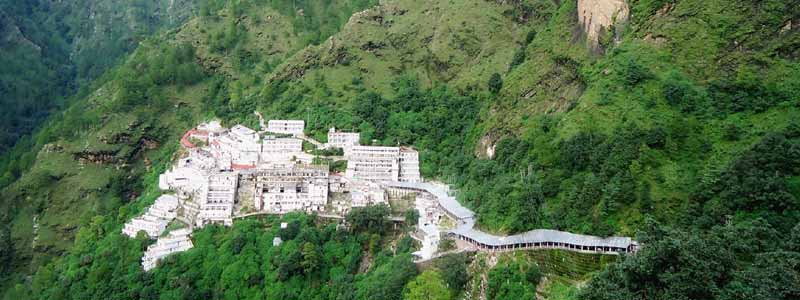
Best Time to Visit Vaishno Devi
The best time to visit Vaishno Devi is during the months of March to October, which coincides with the spring, summer, and early autumn seasons in the region. During this time, the weather is pleasant and favorable for undertaking the pilgrimage and exploring the surrounding areas. Here’s a breakdown of the different seasons and their advantages:
Spring (March to April): Spring is a beautiful time to visit Vaishno Devi as the weather is mild, and the natural surroundings are lush and colorful due to the blooming flowers. The Navratri festival, celebrated during this period, adds to the festive ambiance of the pilgrimage.
Summer (May to June): Summer is the peak tourist season for Vaishno Devi due to the summer vacations in schools and colleges. The weather is pleasant, and temperatures are moderate, making it comfortable for pilgrims to undertake the 13-kilometer trek to the temple. The evenings are cooler, allowing for a peaceful and enjoyable darshan (visit) of the deity.
Monsoon (July to September): Monsoon brings heavy rainfall to the region, and landslides are common during this period. The trek can become challenging and risky due to slippery paths and limited visibility. It is advisable to avoid visiting during the monsoon season for safety reasons.
Autumn (October): Early October is a favorable time to visit Vaishno Devi as the weather is still pleasant before the onset of winter. The Navratri festival in this month adds to the religious fervor, making it a spiritually significant time for pilgrims.
Winter (November to February): Winter brings cold temperatures to Vaishno Devi, especially during December and January. The region experiences snowfall, and the trekking paths can be icy and difficult. Despite the chilly weather, some devotees may choose to visit during the winter months, but it’s essential to be well-prepared for the cold Vaishno Devi Travel Information.
Ultimately, the best time to visit Vaishno Devi depends on personal preferences and the ability to undertake the pilgrimage comfortably. If you prefer pleasant weather and a vibrant atmosphere, consider visiting during the spring or summer months. However, if you enjoy colder climates and don’t mind the possibility of snow, visiting during early October or the winter months may also be rewarding. Avoid visiting during the monsoon season due to safety concerns and trekking difficulties.
How to Reach Vaishno Devi
Vaishno Devi, located in Indian-administered Kashmir, is accessible via various modes of transportation. The nearest major town is Katra, which serves as the base camp for the pilgrimage. From Katra, visitors can reach the Vaishno Devi Temple through a trek or by using various transportation options. Here’s how to reach Vaishno Devi:
By Air: The nearest airport to Vaishno Devi is the Jammu Airport (Satwari Airport), located in Jammu city, approximately 50 kilometers from Katra. From the airport, you can hire a taxi or use public transport to reach Katra.
By Train: The nearest railway station to Vaishno Devi is the Shri Mata Vaishno Devi Katra Railway Station, which is well-connected to major cities in India. Several trains, including express and superfast trains, stop at Katra Railway Station. From the station, you can hire a taxi or an auto-rickshaw to reach the Katra base camp.
By Road: Katra is well-connected to major cities and towns in northern India by road. Regular bus services, both government and private, operate to and from Katra. You can also hire a taxi or drive your own vehicle to reach Katra.
Trek to the Temple: The pilgrimage to Vaishno Devi Temple begins from Katra, and visitors can undertake a 13-kilometer uphill trek to reach the temple. The well-paved path is accessible to pedestrians and vehicles up to a certain point. Many pilgrims prefer to trek on foot, while others use ponies, palanquins, or electric vehicles for a part of the journey.
Helicopter Service: For those who prefer a quicker and more convenient mode of transport, there is a helicopter service available from Katra to Sanjichhat, which is a point closer to the temple. From Sanjichhat, it is a short walk or a ride in a ropeway to reach the temple. However, this service is subject to weather conditions and availability Vaishno Devi Travel Information.
It’s important to note that the Vaishno Devi pilgrimage experiences high footfall, especially during festivals and peak tourist seasons. It is advisable to plan your trip in advance and book your accommodations and transportation accordingly. Additionally, check the weather conditions and any travel advisories before embarking on the pilgrimage, especially during monsoon and winter seasons, as they can affect travel arrangements.

